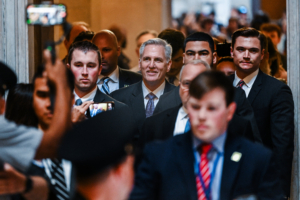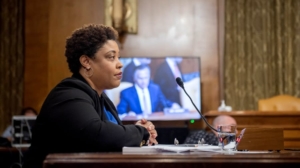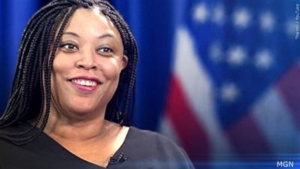
The ‘Essential Figure’ Inserted Trust into Fragile Negotiations
 Taking the nation to the brink of default is a dangerous road to travel. The people who narrowly avoided the cliff deserve praise. One of those deserving people is someone most Americans don’t recognize.
Taking the nation to the brink of default is a dangerous road to travel. The people who narrowly avoided the cliff deserve praise. One of those deserving people is someone most Americans don’t recognize.
House Speaker Kevin McCarthy, President Joe Biden and Congressman Patrick McHenry are public figures who played pivotal roles in pushing for a debt ceiling deal that Congress is on the verge of approving. However, Shalanda Young, director of the Office of Management and Budget (OMB), may have been the “essential figure” that enabled both sides to come together, reach a deal and claim victory.
If you listened to McCarthy’s daily press briefings, you would have thought there was no chance for a deal. He complained Biden wasn’t negotiating. When Biden did come to the table, McCarthy complained he had been captured by the socialist wing of the Democratic Party.
Biden, no stranger to high-stakes political bargaining, bided his time. His criticism of MAGA Republicans was muted. He didn’t take aim at McCarthy or respond to his criticism. He already had succeeded in moving Social Security and Medicare off the table before negotiations began.
McHenry, a Republican serving his 10th term representing North Carolina, was chosen by McCarthy as one of his two lead negotiators and to act as the public face of day-to-day progress reports. He was seen at all hours of the day and night coming and going from negotiating sessions at the White House and on Capitol Hill.
The general public had no idea Young was involved in the negotiations or that her involvement convinced McCarthy and McHenry the negotiations were finally serious.
That’s why McCarthy expressed optimism following a White House meeting with Biden after learning Young would be among Biden’s lead negotiators. “What has changed in this meeting is the President changed the scope of who’s negotiating,” McCarthy told reporters outside the White House, referencing Young. “Everybody in this place knows her and respects her greatly.”
Negotiations from that point only took a week and a half to reach an “agreement in principle”. The House and Senate voted overwhelmingly to approve the legislation before Monday’s default deadline.
“I want to know their value statements and they need to know mine. And we have to find a middle ground. They shouldn’t have to compromise their values, and neither should we.”
 The Roles They Played
The Roles They Played
McCarthy’s daily bluster provided cover for his fractured caucus, even as former President Trump urged the Freedom Caucus to let the debt ceiling deadline expire and see what happens. McCarthy wasn’t eager to find out, even knowing the deal he would have to strike would displease far-right caucus members and possibly put his speakerships at risk.
Biden’s coy tactics betrayed his long congressional experience that it takes a brink to reach a deal. Biden publicly toyed with unilateral action such as invoking the 14th Amendment’s provision that declares the United States pays its bill. He went to Japan for a critical G-7 meeting but agreed to cut short his Pacific Rim trip to return home for debt ceiling negotiations. All the while, Biden was in close touch with his negotiators, waiting for the right moment.
McHenry, who chairs the House Financial Services Committee, played a highly visible but low-key role. His job was to get as much as he could from negotiations to satisfy McCarthy that the deal could pass in the House with support from at least two-thirds of his caucus (it did).
Amid the negotiators, Young’s role was to supply the facts and provide reality checks, just as she had done for a decade on the staff of House Appropriations, working with Republicans and Democrats. We may never know who came up with different elements of the deal, but we can be pretty sure Young’s facts and reality checks played a key role.
One of the touchiest issues in the negotiation was McCarthy’s demand for tougher work requirements to receive federal assistance. In the final deal, work requirement changes only affected the Supplemental Nutrition Assistance Program (SNAP). There were two main changes – raising the work requirement for applicants from age 50 to 54 and excusing veterans and people experiencing homelessness from work requirements.
The Congressional Budget Office estimated the changes will increase direct spending for SNAP by $2.1 billion between 2023 to 2033. McCarthy got a talking point; Biden avoided serious cuts (no changes were made to Medicaid eligibility). It’s likely Young was at the center of the trade-off that allowed both sides to “win”.
 Young’s Unique Contribution
Young’s Unique Contribution
The Washington Post reported, “The intensive negotiations thrust Young, 45, into the center of a fight with sweeping economic and political ramifications. To many participants, she seemed to become an indispensable figure, a rare individual who was known and trusted by members of both parties and could serve as a conduit at a moment when partisan recriminations have reached a fever pitch.”
Young’s current and former colleagues noted she has been in the middle of budget fights for more than a decade as a staff member and later staff director for the House Appropriations Committee. They said she “works mostly behind the scenes, specializing in the details while developing strong relationships with Democrats and Republicans.”
Lawmakers from both parties viewed Young as someone who understood what was important to achieve in the negotiations. She had a similar, lower-profile role in the 2019 debt ceiling stand-off.
“We saw the partisan process play out,” Young said in an NPR interview. “Now we needed to pivot to a bipartisan process. That’s the only thing that’s going to make it to the President’s desk and avoid default.”
The Post article quoted Young describing her approach. “The most important thing is to know what they have to have. You have to be clear about what you have to have. I want to know their value statements and they need to know mine. And we have to find a middle ground. They shouldn’t have to compromise their values, and neither should we.”
“I know a lot of members of Congress. What you don’t do is call and tell them what to do,” Young said. “You educate. You say, ‘Let me know what you need to know, what’s in this bill, how it’s written, how it’s going to be implemented. We’re here to answer you.’”
Part of her job is convincing congressional Democrats to vote for the deal. “My job is to tell members what’s in the bill,” she told the Post. “You get into trouble when you try to tell members what their opinion is. Every member should have whatever opinion. Our job is to say, ‘This is what’s in the bill. This is how some of the worst things Republicans wanted were mitigated.’”
 Young’s Background
Young’s Background
Young grew up in Clinton, Louisiana before attending Loyola University in New Orleans where she earned a degree in psychology. She remained in the Big Easy to take her master’s degree from Tulane University in health administration. She moved to Washington, DC in 2001 as a presidential fellow at the National Institutes of Health.
Eventually she landed a Capitol Hill job on the House Appropriations staff and in 2017 became its staff director, orchestrating historic congressional funding during the COVID-19 pandemic and earning the respect of Republicans and Democrats in the process.
When Biden became President, he nominated Young as deputy director of OMB. Her House hearing was a love fest with Republicans singing her praises. She faced a rougher road in the Senate where GOP senators voiced concern about her views on the Hyde Amendment, which prohibits federal funding for abortions.
When the nomination of Neera Tanden as OMB director ran into political trouble, congressional Democrats turned to Young as the alternative. Her nomination was supported by Speaker Nancy Pelosi, South Carolina Congressman Jim Clyburn and South Carolina GOP Senator Lindsey Graham, who said:
“I think you are a highly qualified person for the job. Everybody that deals with you on our side has nothing but good things to say. You might talk me out of voting for you, but I doubt it. Thank you.” Young was confirmed as OMB Director on a 61-36 vote.
Her colleagues describe Young as serious with a light side attuned to pop culture. She likes to crack jokes and is a talented photographer, whose work of her native Louisiana and Mardi Gras celebrations graces her OMB office walls.
In her professional life, Young is credited with “encyclopedic knowledge” of the federal budget and the varying rationale of members who support different programs.
“What was most important was she really understands the issues and knew the numbers,” according to former Democratic Congresswoman Nita M. Lowey who chaired the House Appropriations Committee when Young was its staff director. “She was a delight. She was hard-working. She was smart.”
With a deal reached and Congress on track to approve it, Young confessed she is tired and out of laundry. “I didn’t have time to do laundry or take anything to the dry cleaner. So that’s about how my last two weeks have gone,” Young said, adding she plans to spend down time with her two-year-old daughter.




